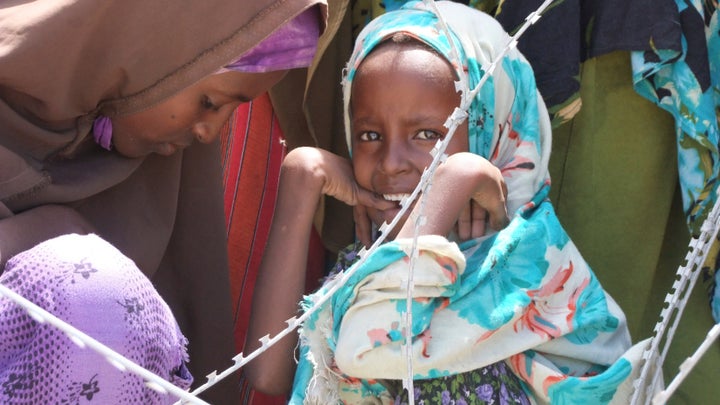
Imagine you are a woman, forced to leave your home and community because there is no food or water to feed your family. You must walk hundreds of miles with your children to a refugee camp in another country. As you make your long trek, you watch other mothers carrying their own starving and malnourished children, on the brink of death -- or already dead -- and pray that your own children will survive, in the sun, in the heat, with only a few sips of water to keep them going. You encounter violent militias and armed bandits along the way who leer at and threaten you and your daughter. Imagine that you cannot ward them off, and your daughter is kidnapped and raped.
This scenario plays out every day in the Horn of Africa as thousands of Somalis, the overwhelming majority of them women and children, flee their country to find food and shelter in neighboring Kenya and Ethiopia. Yet when they finally reach the camps, which are supposed to be safe havens, they find that the dangers continue, and are sometimes even worse.
Thousands of refugees have reached camps like Dadaab in Kenya -- the biggest refugee complex in the world. Built for 90,000 people, it now hosts nearly five times that number. While we have been hearing news stories about the desperate need for food, water and basic health care, we have heard little about the appalling sexual violence women and girls there face every day.
Many of the displaced Somalis are in areas on the outskirts of the established camps; they live in ad hoc settlements that lack security and basic services like latrines. The International Rescue Committee found a fourfold increase in reports of sexual violence at Dadaab in June 2011 compared to January-May. The real numbers are likely much higher, because many women and girls fail to report attacks for fear of their safety, because they don't want to be ostracized by their families and communities or because they don't trust that their rapists will ever be caught or prosecuted. Some of those living in the camps also face violence from their partners, and some are being forced into early marriage or survival sex, because they have no other way to support themselves.
The world can -- and must -- act quickly to stop this. While managing the sheer number of people at the camps is a daunting challenge for those on the ground, getting it right now will more effectively protect women and girls than trying to fix problems after they have become entrenched.
Based on years of research and direct experience, the Women's Refugee Commission has identified the top ten critical needs facing displaced women and girls in crisis-affected settings. Our immediate recommendations include not only ensuring that they have safe access to basic necessities, such as food, cooking fuel, potable water, sanitation and shelter, but that they are protected from sexual violence and that health care, particularly reproductive health care, is available. Victims of sexual violence must also receive psychosocial support. The recently updated Minimum Initial Service Package for reproductive health outlines the basic measures needed to respond to the priority reproductive health needs of women and girls from the onset of a crisis. Governments and humanitarian agencies have initiated these efforts, but activities must be rapidly scaled up to meet the magnitude of the need.
One of the greatest risks the women and girls face arises out of what should be a simple task -- cooking for their families. Most of the food rations they receive from humanitarian agencies -- lentils, flour and a corn-soya blend -- need to be cooked. But often they don't receive cooking fuel, and firewood is becoming harder and harder to find because of widespread deforestation caused by the large influx of displaced persons over the past several decades. Women and girls have to go deeper into the desert around the camps to find wood, which makes them more vulnerable to sexual assault and rape. The solution is simple: they should have safe access to the cooking fuel required to cook the food rations they receive. Given the level of environmental degradation in the region, this will require the international community to invest more in alternative fuel sources and to promote fuel-efficient stoves.
There are other solutions that should not be difficult to implement. For example, women's and girls' risks of sexual violence would be greatly reduced if the camps had better lighting, latrines with locks and tighter security.
As the world responds to this and other emergencies, the particular plight of women and girls has to be put into better focus. Humanitarian agencies must recognize that women and girls are almost always among those at most risk in such crises and that their specific needs -- and rights -- must be met. If we don't take these most basic measures to protect them, we will further compound the tragedy and the devastating impact it is having on them.
It's time to put the lives and safety of women and girls at the top of the humanitarian agenda.
